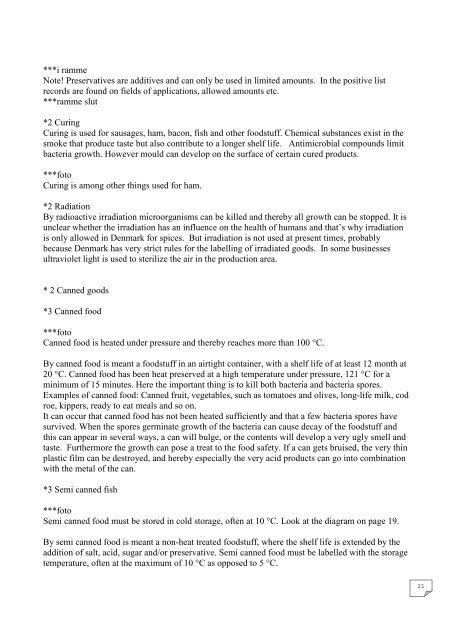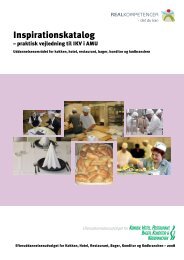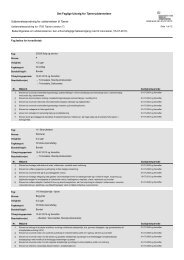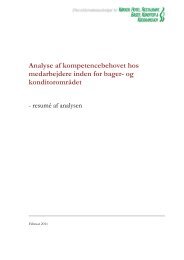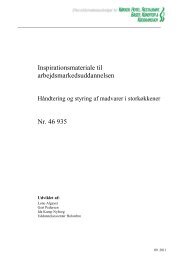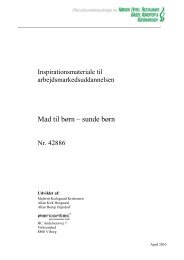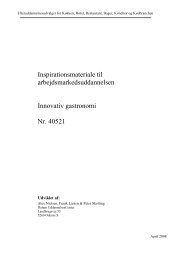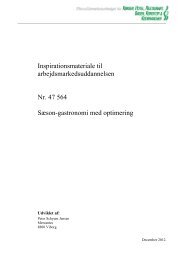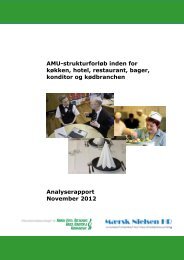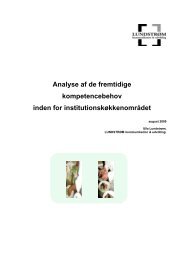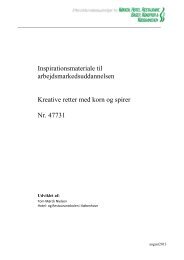General food hygiene - the certificate training
General food hygiene - the certificate training
General food hygiene - the certificate training
Create successful ePaper yourself
Turn your PDF publications into a flip-book with our unique Google optimized e-Paper software.
***i ramme<br />
Note! Preservatives are additives and can only be used in limited amounts. In <strong>the</strong> positive list<br />
records are found on fields of applications, allowed amounts etc.<br />
***ramme slut<br />
*2 Curing<br />
Curing is used for sausages, ham, bacon, fish and o<strong>the</strong>r <strong>food</strong>stuff. Chemical substances exist in <strong>the</strong><br />
smoke that produce taste but also contribute to a longer shelf life. Antimicrobial compounds limit<br />
bacteria growth. However mould can develop on <strong>the</strong> surface of certain cured products.<br />
***foto<br />
Curing is among o<strong>the</strong>r things used for ham.<br />
*2 Radiation<br />
By radioactive irradiation microorganisms can be killed and <strong>the</strong>reby all growth can be stopped. It is<br />
unclear whe<strong>the</strong>r <strong>the</strong> irradiation has an influence on <strong>the</strong> health of humans and that’s why irradiation<br />
is only allowed in Denmark for spices. But irradiation is not used at present times, probably<br />
because Denmark has very strict rules for <strong>the</strong> labelling of irradiated goods. In some businesses<br />
ultraviolet light is used to sterilize <strong>the</strong> air in <strong>the</strong> production area.<br />
* 2 Canned goods<br />
*3 Canned <strong>food</strong><br />
***foto<br />
Canned <strong>food</strong> is heated under pressure and <strong>the</strong>reby reaches more than 100 °C.<br />
By canned <strong>food</strong> is meant a <strong>food</strong>stuff in an airtight container, with a shelf life of at least 12 month at<br />
20 °C. Canned <strong>food</strong> has been heat preserved at a high temperature under pressure, 121 °C for a<br />
minimum of 15 minutes. Here <strong>the</strong> important thing is to kill both bacteria and bacteria spores.<br />
Examples of canned <strong>food</strong>: Canned fruit, vegetables, such as tomatoes and olives, long-life milk, cod<br />
roe, kippers, ready to eat meals and so on.<br />
It can occur that canned <strong>food</strong> has not been heated sufficiently and that a few bacteria spores have<br />
survived. When <strong>the</strong> spores germinate growth of <strong>the</strong> bacteria can cause decay of <strong>the</strong> <strong>food</strong>stuff and<br />
this can appear in several ways, a can will bulge, or <strong>the</strong> contents will develop a very ugly smell and<br />
taste. Fur<strong>the</strong>rmore <strong>the</strong> growth can pose a treat to <strong>the</strong> <strong>food</strong> safety. If a can gets bruised, <strong>the</strong> very thin<br />
plastic film can be destroyed, and hereby especially <strong>the</strong> very acid products can go into combination<br />
with <strong>the</strong> metal of <strong>the</strong> can.<br />
*3 Semi canned fish<br />
***foto<br />
Semi canned <strong>food</strong> must be stored in cold storage, often at 10 °C. Look at <strong>the</strong> diagram on page 19.<br />
By semi canned <strong>food</strong> is meant a non-heat treated <strong>food</strong>stuff, where <strong>the</strong> shelf life is extended by <strong>the</strong><br />
addition of salt, acid, sugar and/or preservative. Semi canned <strong>food</strong> must be labelled with <strong>the</strong> storage<br />
temperature, often at <strong>the</strong> maximum of 10 °C as opposed to 5 °C.<br />
21


